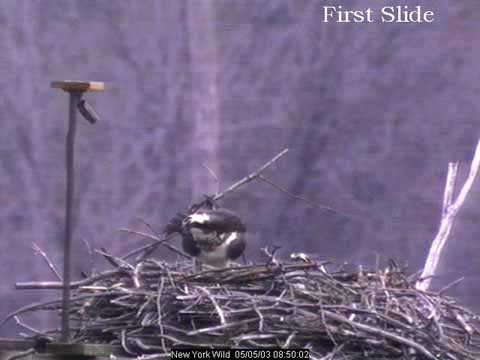Osprey Nest at Montezuma National Wildlife Refuge

There is a new image every 5 seconds with a total of 28 images.
I have identified the first and last image.
This camera showed the osprey nest at the North Spring Pool of the Montezuma National Wildlife Refuge. New for 2003, we installed a close-up camera on the osprey nest platform. Returning visitors may note that this camera view had been interrupted when muskrats chewed the video cable across the pool. That cable has now been restored. Staff at the visitor center had noted by the behavior of the adults that the chicks began to hatch on May 27. Chicks in the nest create a strong bond for the adults, so a mission to repair the cable was planned. A canoe was used to approach the nest platform directly to attach a new cable below the nest. The new cable was then unrolled from a spool in the canoe as we returned to shore. The female was off the nest no more than five minutes for the entire operation. Upon advice from refuge staff, a warm day with the sun moderated by haze was chosen. As the signal from the new osprey camera was reconnected to the visitor center at the refuge, we were able to determine that there are three young chicks in the nest.
It was fascinating to monitor the fight for survival of these three young chicks with the close-up view provided by the osprey cam. Last year, four chicks hatched, but only one survived. A heavy cold rainstorm that occurred when the chicks were too large to find shelter under the mother is the likely cause of that loss. This year, we had another cold and heavy rain event on May 30 and 31 just when the chicks were hatching. Fortunately any chicks that were out of the egg when this rain event occurred were still small enough to find shelter under the mother.
However, on August 15, 2003, one of the 3 osprey chicks was observed on the webcam dead on the nest. This one chick never seemed quite as active as the other two, although it did fledge successfully, and had been flying for some weeks. Osprey chicks typically return to the nest to rest or feed, but this one seemed to spend more time on the nest than the others. The dead chick has been removed from the nest and will be examined to determine the cause of death. We will post an update on the website when we learn more.
General information about Ospreys
About the Montezuma National Wildlife Refuge
Travels of “Zuma” the female Osprey
On June 20, 2001, the female osprey on the North Spring Pool was captured and fitted with a radio transmitter which could be monitored by satellite. She left the refuge on August 26, 2001, and followed the Appalachian Mountains to arrive in southern Florida on September 6, 2001. She then crossed the Carribean to Cuba and continued to the Dominican Republic. Her crossing from the Dominican Republic to the islands off the coast of Venezuela took two days, arriving in Venezuela on September 18, 2001. She spent several weeks crossing Venezuela and then went south to arrive in the heart of Brazil on the Amazon River on October 9, 2001. Unfortunately, the tracking of the return flight was interrupted by a transmitter failure, but the signal was picked up again in 2002 as she arrived back in the United States along the Appalachian Mountains.
 The female osprey used to sport a transmitter with an antenna on her back. The antenna was clearly visible in this picture of Zuma and her mate recorded in April 2002. Zuma was subsequently captured to remove the transmitter. She is now identified by the green and silver bands on her legs. The female osprey used to sport a transmitter with an antenna on her back. The antenna was clearly visible in this picture of Zuma and her mate recorded in April 2002. Zuma was subsequently captured to remove the transmitter. She is now identified by the green and silver bands on her legs.
|

